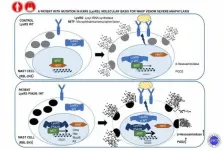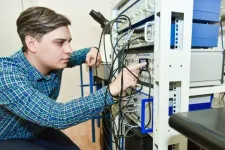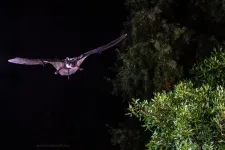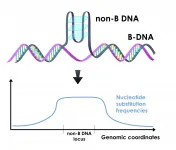Experiment shows how our visual system avoids overloading
2021-02-09
(Press-News.org) Russian researchers from HSE University have studied a hypothesis regarding the capability of the visual system to automatically categorize objects (i.e., without requiring attention span). The results of a simple and beautiful experiment confirmed this assumption. The paper was published in the journal Scientific Reports. The study was supported by a Russian Science Foundation grant.
Humans receive a lot of information from the environment through their vision. Every day, we face a flow of varied visual stimuli. At the same time, information processing requires cognitive resources. Like a computer processor, the human brain has limited capacity in terms of the data it is able to process and save in its memory. One hypothesis states that the visual system somehow 'decreases files' resolution in order to avoid overloading. As a result of such 'compression', instead of a detailed analysis of the observed objects, the visual system categorizes them by simple general attributes, such as size. Later, such 'primary data' can be used for a more thorough analysis.
Researchers sought to answer the following question: is the visual system capable of automatic object categorization (i.e., without attention)? In their study, the researchers tried to determine the conditions in which such automatic categorization would work. They used the visual mismatch negativity (vMMN) component measured by electroencephalography (EEG) as a marker of automatic sensory discrimination. vMMN shows the difference between the brain's reactions to a standard (frequent) or a deviant (rare) stimulus. vMMN demonstrates that the visual system noticed a difference between stimuli and, importantly, that it did so without requiring attention.
'We are very interested and amazed by the human visual system's ability to categorize high numbers of objects. For example, when humans look at an apple tree, they immediately differentiate apples from leaves. This study shows that the process of quick categorization can be performed automatically based on the information on differences between objects', says Vladislav Khvostov, Junior Research Fellow at the HSE Laboratory for Cognitive Research, School of Psychology, one of the paper's authors.
To study the automatic distribution of objects into groups using vMMN, the researchers conducted a simple experiment with a fillertask. Study participants were asked to look at a small asymmetrical cross in the centre of the field and press the button each time the cross changed its orientation. This way, the participants' attention was focused on the position of the cross in the centre of the field. The cross was surrounded by rows of lines of varied lengths and orientation. In each experiment block, the combination of these parameters was different. While the participants' attention was focused on the central figure, the researchers used EEG to record brain activity in response to background visual stimulation. In each block of the experiment, the participants were shown 700 visual stimuli, each of which was presented on the screen for 200 ms followed by 400 ms of empty screen. Most of the stimuli included a fixed combination of lines' length and orientation (for example, long lines were steep, and short ones were flat), but in 10% of cases, the combination of parameters was the opposite.
According to Vladislav Khvostov, the only task for the participants was to press a button when the central cross rotated (third image from the left). In the image above, the central cross size is magnified for illustrational purposes. Together with the cross, the participants observed a background visual stimulation consisting of lines with different lengths and orientations. In most cases (standard stimuli) the combination of length and orientation was the same: long lines were flat, and short ones were steep, but in very rare cases (deviant stimuli, seventh image) this combination changed to the opposite: long lines became steep, while short ones became flat. The participants did not pay attention to the change of stimuli, but analysis of EEG indicators showed that the visual system tracked these changes as well.
The researchers were interested in the brain's reaction to the replacement of a standard stimulus with a deviant one. If the feature had only two peak values (short/long in case of length; vertical/horizontal in case of orientation), it was called 'segmentable'. If the attribute had interim values, it was defined as 'non-segmentable.'
The researchers found considerable visual mismatch negativity in response to a deviant stimulus in cases when either both of the features were segmentable, or only length was. Since on all stimuli inside each block, the distribution of lengths and orientations remained constant, the researchers concluded that categorization was not made by one simple feature. This means that the visual system categorized the lines by their combinations. In their experiment, the researchers thus contradicted the assumption that the visual system categorizes the objects only by simple feature. It can solve a less trivial version of the task and use combinations of features.
INFORMATION:
[Attachments] See images for this press release:

ELSE PRESS RELEASES FROM THIS DATE:
2021-02-09
Anaphylaxis is a systemic allergic reaction that can affect the skin, the gastrointestinal tract, the respiratory system and the cardiovascular system. The most severe form of anaphylaxis is anaphylactic shock, which features hypotension and can cause death. This reaction can have several causes, such as allergic reactions to food, medicines or insect venom.
The molecular mechanisms that cause the severity of these kinds of reactions is still unknown. In a study led by researchers of the University of Barcelona and IDIBAPS, researchers analyzed the mutation of a gen detected in a patient who suffered from recurrent anaphylactic shocks caused ...
2021-02-09
Growing the right crop in the right place within an impaired watershed can achieve significant water quality improvements, according to Penn State researchers, who conducted a novel study in the drainage of a Susquehanna River tributary in an agricultural area in southeastern Pennsylvania.
The research may reveal a potential path for restoring the troubled Chesapeake Bay, said Patrick Drohan, associate professor of pedology in the College of Agricultural Sciences and one of the study's authors. The bay -- which long has been impaired in large part by nutrients and sediment washing off crop fields and getting into surface waters that feed it -- needs bold solutions, such as changing cropping systems, he suggested.
"Other than when wastewater treatment plants came into compliance ...
2021-02-09
BROOKLYN, New York, Monday, February 8, 2021 -- A holy grail for orthopedic research is a method for not only creating artificial bone tissue that precisely matches the real thing, but does so in such microscopic detail that it includes tiny structures potentially important for stem cell differentiation, which is key to bone regeneration.
Researchers at the NYU Tandon School of Engineering and New York Stem Cell Foundation Research Institute (NYSF) have taken a major step by creating the exact replica of a bone using a system that pairs biothermal imaging with a heated "nano-chisel." In a study, "Cost and Time Effective Lithography of Reusable Millimeter Size Bone Tissue Replicas with Sub-15 nm Feature Size on a Biocompatible ...
2021-02-09
A team of researchers from the Laboratory of Biophysics at NUST MISIS, Lomonosov Moscow State University and D. Mendeleev University of Chemical Technology of Russia has summarized metal-containing diagnostic agents for positron emission tomography (PET), magnetic resonance imaging (MRI), and single-photon emission computed tomography (SPECT) imaging of Alzheimer's disease (AD). According to the researchers, metal-containing radiopharmaceuticals are not only highly effective for detecting early markers of Alzheimer's disease, but also synchrotron-independent and ...
2021-02-09
Bats are the only mammals that can actively fly. Some species travel over one hundred kilometres on their nocturnal excursions in search of food. Researchers at the Max Planck Institute of Animal Behavior in Radolfzell have now discovered that European free-tailed bats use uplifting winds for their ascents - a behaviour that was previously known only from birds. To do this, they tracked the bats using mini GPS loggers and then linked the flight data to weather data. The animals can thus gain altitude of well over 1,000 metres without expending much energy. The results ...
2021-02-09
DNA sequences that can fold into shapes other than the classic double helix tend to have higher mutation rates than other regions in the human genome. New research shows that the elevated mutation rate in these sequences plays a major role in determining regional variation in mutation rates across the genome. Deciphering the patterns and causes of regional variation in mutation rates is important both for understanding evolution and for predicting sites of new mutations that could lead to disease.
A paper describing the research by a team of Penn State scientists is available online in the journal Nucleic Acids Research.
"Most of the time we think about DNA as the classic ...
2021-02-09
A 'biological age' score predicts that being male, overweight, a smoker and having depression all contribute to biological aging, a study published today in eLife reports.
Aging can be measured in different ways. While chronological age is measured by date of birth, scientists have developed a range of measurements to determine our biological age. These include measuring the length of telomeres (little caps on the end of our chromosomes that shorten as we grow older), chemical changes to our DNA (epigenetics), and changes to the proteins and metabolites in our bodies ...
2021-02-09
According to the Education Act, schools in the ethnically divided Bosnia and Herzegovina must teach students "democratic ideals in a multicultural society." But according to new research from the University of Copenhagen, the opposite happens: Segregated schools perpetuate ethnic divisions between Croats, Serbs and Bosniaks, making reconciliation after the 1992-1995 wars extremely difficult.
25 years ago, the warring factions in the war in former Yugoslavia signed a peace agreement. Bosnia and Herzegovina, where 100,000 people lost their lives during the war, is now an independent state comprising the Bosnian-Croatian Federation and the Republika Srpska. It is a division that ...
2021-02-09
Social conflicts, from policy debates to family disagreements, can easily devolve into angry words and personal attacks. Such heated confrontations, however, seldom resolve disagreements and can entrench opposing views.
A better approach to resolving interpersonal disagreements is to embrace characteristics that psychological scientists associate with wisdom, like intellectual humility, diverse viewpoints, and open-mindedness.
But applying these elements of wisdom can be difficult, especially during confrontations. The trick, according to new research published ...
2021-02-09
The global problem of unowned domestic cats, driven by the cats' phenomenal reproductive success, carries significant economic, animal welfare and biodiversity costs. Big-data research led by an expert on veterinary medicine and infectious diseases at City University of Hong Kong (CityU) has found that although more than 80% of cats in Australia were desexed, only a fraction have had surgery before reaching puberty, thus creating a "pregnancy gap". To close this gap and prevent unwanted litters, it is recommended that the age of desexing is before four months.
The research was led by Professor ...
LAST 30 PRESS RELEASES:
[Press-News.org] Experiment shows how our visual system avoids overloading







